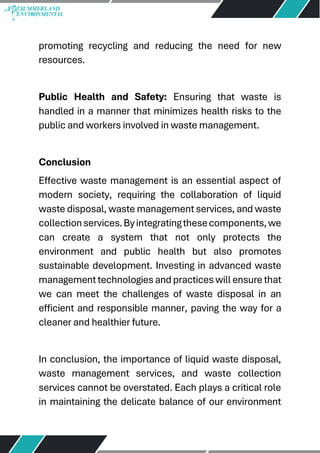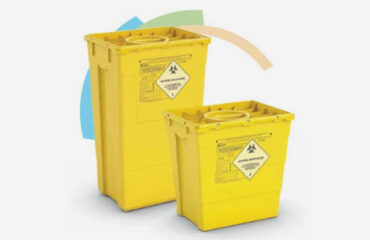Not known Facts About Reclaim Waste
The Only Guide to Reclaim Waste
Table of ContentsEverything about Reclaim WasteNot known Factual Statements About Reclaim Waste Fascination About Reclaim WasteThe Buzz on Reclaim WasteThe Best Guide To Reclaim Waste
Explore the types, incidents, and types of fluid waste. Domestic sewage waste describes the waste and items from a residential sewage-disposal tank. This sort of waste is created by humans in homes, institutions, and various other structures. This only includes sewage-disposal tanks that have a drain field. The appropriate administration and disposal of residential sewage waste need liquid waste to be transferred to a sewer treatment plant where the appropriate methods and devices are put on cleanse and dispose of waste.
Business waste typically includes prospective risks, such as flammable products or a mix of liquid and solid waste items, and requires an advanced and in-depth disposal procedure. The disposal of industrial waste usually entails the filtering of waste before transport to guarantee secure and proper disposal. Hazardous waste is created from by-products and drainage of industrial processes and manufacturing.
This kind of waste can not make use of the exact same sewage management transport or processes as septic or commercial liquids. The industrial waste administration process needs the evaluation and testing of fluid waste before it undertakes the disposal procedure (industrial wastewater treatment). Runoff waste is the liquid waste that comes from overflow and excess stormwater in highly inhabited areas or cities
Runoff waste can trigger contamination and flooding if not dealt with effectively. Find out extra regarding drain cleaning and waste monitoring. Making sure correct waste management can stop disasters and reduce ecological injury. Both people in domestic settings and specialists in industrial or production industries can take advantage of recognizing the procedures and regulations of liquid waste monitoring.
All about Reclaim Waste
Contact PROS Providers today to learn more about our waste monitoring and disposal services and the proper ways to look after the fluid waste you create.
(https://boom-fruit-496.notion.site/Industrial-Wastewater-Treatment-The-Key-to-a-Cleaner-Greener-Future-13c9fdbb2e9380eca32fee3a79088ddf?pvs=4)Do you know what takes place to your water when you end, purge the bathroom or drain the cleaning device? No? Well, it's worth understanding. This supposed 'wastewater' is not just an essential resource but, after treatment, will certainly be released to our land, waterways or the sea. Utilized water from bathrooms, showers, bathrooms, kitchen sinks, washings and commercial procedures is referred to as wastewater.

water made use of to cool machinery or clean plant and devices). Stormwater, a type of wastewater, is overflow that streams from farming and city locations such as roof coverings, parks, gardens, roads, paths and seamless gutters into stormwater drains pipes, after rainfall. Stormwater moves untreated directly to local creeks or rivers, eventually reaching the sea.
Some Known Details About Reclaim Waste
In Queensland, a lot of wastewater is treated at sewer treatment plants. Wastewater is transported from residential or industrial websites through a system of sewers and from this source pump terminals, called sewerage reticulation, to a sewage therapy plant. City governments construct, preserve and run most sewage therapy plants. Operators are licensed under the Environmental Protection Act 1994 to discharge cured wastewater at an acceptable environmental standard into waterways.
The Department of Natural Resources recommends local governments concerning handling, operating and keeping sewerage systems and therapy plants. In unsewered areas, neighborhood federal governments may call for homeowners to set up individual or family sewer therapy systems to treat residential wastewater from toilets, kitchen areas, restrooms and laundries. The Department of Natural Resources authorizes making use of family systems when they are shown to be efficient.
In some new neighborhoods, therapy of some stormwater to remove clutter, sand and crushed rock has begun making use of gross toxin catches. Wastewater treatment takes place in 4 phases: Eliminates strong issue.
Wastewater after that moves into huge storage tanks where solids work out and are eliminated as sludge. Grease and residue are skimmed from the surface. Makes use of small living microorganisms recognizes as micro-organisms to damage down and eliminate continuing to be liquified wastes and great fragments. Micro-organisms and wastes are integrated in the sludge. Removes nitrogen and phosphorus nutrients that could trigger algal blooms in our rivers and intimidate marine life.
Reclaim Waste - Truths
Nutrient removal is not offered at all sewer therapy plants because it requires expensive specialized equipment. It is ending up being extra typical in Queensland. Clear fluid effluent created after therapy might still consist of disease-causing micro-organisms. If this effluent is launched into waterways such as rivers or the sea, the micro-organisms will at some point die out.

This generally means wastewater has actually to be dealt with or impurities removed before it can be released to waterways. The majority of wastewater moves into the sewerage system. Under the Act, local federal governments carry out authorizations and permits for environmentally appropriate tasks (Ages) including wastewater releases that may have a neighborhood effect. The department administers authorizations and licences to Ages including wastewater releases that could have a local or statewide influence.
All About Reclaim Waste
Otherwise, samples are considered lab evaluation. Often numerous tests are required to establish the levels of each of the different pollutants such as oils, heavy steels and chemicals in water. Monitoring gives valid information regarding water high quality and can confirm that licence problems are being satisfied. The information obtained with monitoring offers the basis for making water top quality decisions.